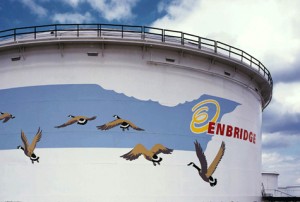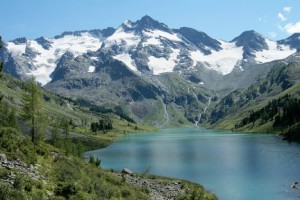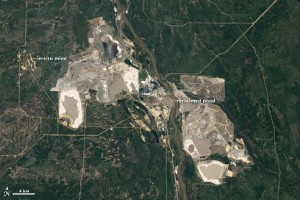A disturbing article on the effect of tar sands on birds from Canadian blogger Sharon McInnes:
Some of Enbridge’s oil tanks are decorated with illustrations of lovely Canada Geese in flight. Let’s just hope they don’t land in the tar sands tailing ponds.
Almost all the largest oil companies are currently mining and drilling in the Boreal forest and wetlands where more than half of the birds of North America nest. According to The Boreal Forest Region: North America’s Bird Nursery the Boreal Forest is the preferred breeding ground (i.e. they do over 50% of their breeding there) of 96 Western Hemisphere bird species. And a total of 276 species breed within the area when you count species that do at least 5% of their breeding there.
Boreal Forest. Photo by Olga Oslina. Flick’r CC image.
Here’s the bad news: according to the National Resources Defence Council’s December 2008 report, Danger in the Nursery: Impact on Birds of Tar Sands Oil Development in Canada’s Boreal Forest, over the next 30 to 50 years between 6 million and 166 million more birds could be lost as a result of tar sands development, this in addition to the ever-increasing number of species already declining at alarming rates.
Tar sand deposits lie under 141,000 square kilometres of boreal forest and muskeg. NASA photo 2011
Let’s be clear: tar sands are not oil. They are a mixture of approximately 10% bitumen mixed with sand, clay, silt, and water. Bitumen is “what a desperate civilization mines after it’s depleted its cheap oil.” (Tar Sands, Andrew Nikiforuk, 2010) Getting it from its raw state to a state in which it will flow through a pipeline takes a mind-boggling amount of fresh water, a complex network of roads, pipelines, well pads, compressor stations, energy generation facilities, and tailing ponds. It means the devastation of the forest covering the tar sands along with every living thing that called that forest home. Whether the tar is extracted by open-pit mining using 400-ton 3-story high trucks and electric shovels worth $15 million each, or by ‘in situ’ drilling, the result is the same: massive habitat loss and fragmentation, contaminated air and water, loss of huge volumes of water from wetlands, lakes, and rivers, and greenhouse gas emissions triple those of conventional oil drilling. Global warming is just one of the nasty results.



